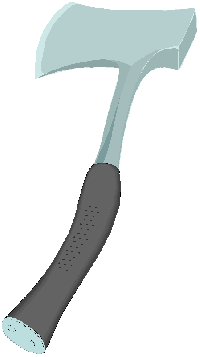

It pays to be straightforward in your approach, and remember that if your methods don't facilitate penalty doubles - your opponents will take liberties against you.
The main difference compared with defending 1 level bids is that you have lost a whole level of bidding, in which you wouild normal explore whether the hand is worth game or not. To get round this you can either provide overcaller with two levels of takeout, or give advancer a mechanism to show weak or intermediate values
The double/lebensohl method | |||
|
|
 The versatile lebensohl 2NT convention has many uses in bridge.
Here we use to distinguish between poor and intermediate hands, when partner has
doubled opponent' weak two for takeout.
The versatile lebensohl 2NT convention has many uses in bridge.
Here we use to distinguish between poor and intermediate hands, when partner has
doubled opponent' weak two for takeout.
The auction goes
(2
Taking the money
|
The Hacket method | |
|
|
Paul Hacket is an English international player, as are his twin sons, and daughter-in-law for Germany)!
In this approach we use the minors as two levels of takeout as a way round that invitational values problem. We maintain an ability to swing the axe. Playing "Hacket" in 2nd position: 
Other bids are as before. As objectives include punishment many would put less
stress on points, protecting 3 The really sophisticated might learn both takeout double and Hacket, prefering the latter when opponents are vulnerable, known kamikazi's, or playing 5 card weak twos. Paul originated this method when weak two's swept England after Albert Benjamin's modification to Acol strong bids. He tells me that he hasn't played it himself for several years. However it might make sense if you play a lot against EHAA style or similar |
Defending Ekren and other 4-4 openings | |
|
|
This advice is based on my own experience playing 2 assumed fit,
and on Scandanavian experience sent to me by Ulf Nillson of the Swedish team. The Scandinavians
tend to meet traditional 2 assumed fit,
and on Scandanavian experience sent to me by Ulf Nillson of the Swedish team. The Scandinavians
tend to meet traditional 2 Ekren. Ekren.
There are two major groups. Those that include the suit bid and those that don't. The latter are restricted, but oddly are easier to defend as you can afford to pass and await events {Bjørn Ekren argues otherwise!} Essentially opponent's bad results come from the non-fit auctions and assumed fit may be a liability if you are confident defenders. Nillson plays his standard "Multi" defence - "as against all weird openings". "After Ekren there may not be any fit, and even if there is opponents often bid to the three level or more, when a simple preference is more appropriate. Consensus in Scandanavia is that good strategy is to double flexibly. Then if lacking a clearcut alternative own contract, convert to penalties". My own suggestions
|
Schuler defence | ||||||||||||||||||||||||||||||||||
|
|
Americans only get to meet wimpy 5-4 assumed fit preempts. ACBL protects them from Europe's "wild type" 4-4.
John Schuler and his partner Michael Crawford developed this structure against
2 assumed fit, which aims to punish. It's not far away from a simple "takeout
double of hearts", but it's the attitude that matters. John's method is based on sound theory, backed up
by simulations and some tabel experience. It also works against Flannery. Or even better against 4-4!! assumed fit, which aims to punish. It's not far away from a simple "takeout
double of hearts", but it's the attitude that matters. John's method is based on sound theory, backed up
by simulations and some tabel experience. It also works against Flannery. Or even better against 4-4!!
|
See also Norwegian defence to the Ekren opening by Tor Eivind Høyland is also available on this site.
A brown sticker opening is generally where there is no guaranteed "anchor" suit - removing a cue bid from any defencing scheme. This page provides some "quick fix" solutions. However - note that you should not meet BS openings in general competition. Where you do opponents must give due notice and suggested defence. You can even read your notes at the table!
The XXX method | |
|
|
Posted by Australian professional Kieran Dyke in the 2003 r.g.b
brown
sticker debate.

XXX covers perfectly well against every two-bid I've ever encountered, including the superfert 2C (0-4 any) played by one forcing pass pair, and the 6-9 any 2C opening from old-style Moscito. RCO twos, Myxos, Tartan twos are easily shrugged off. Opening bids like Ekrens are tougher because of the more ballistic preemption that they can achieve, but that's a consequence of their good definition, not the lack of definition. Playing against Regres or Suspensor (with frequent opening bids showing poor hands with little reference to suits) or coping with the Fert in FP systems requires a little more work, so I can see a case for restricting them to events with 14+ board matches. But in nearly all cases, a few guiding principles should provide simple and effective (if not optimal) defenses to almost all situations that the opponents can produce. Kieran Dyke |
Strong and balanced | |
|
|
 While admitting that these preempts are "hot stuff", UK/European player
and 1970's CUBC
croney John Armstrong suggested this line to me over a curry. John had met with
some quite wierd methods during many successful expeditions into European and
Bermuda Bowl Championships.
While admitting that these preempts are "hot stuff", UK/European player
and 1970's CUBC
croney John Armstrong suggested this line to me over a curry. John had met with
some quite wierd methods during many successful expeditions into European and
Bermuda Bowl Championships.
John is quite properly renowned for his excellent table manners both in the restaurant, and while playing bridge! |
UK team policy | |
|
|
GB coach David Burn posted to the 1998 r.g.b
discussion on the Wilkosz opening:
"Our experiences in the British team, when preparing defences to either-or
two-suited openings, have been as described below".

|
|
|
www.chrisryall.net/bridge/weak.two/generic-defence.htm © Chris Ryall 1987-2008
|